Well, this is the review most of our readers will have been waiting for: the plasma TV that is, by Panasonic’s own wording, the best they’ve ever produced. Well, we’ll see if that turns out to be true: we’ve been scrutinising and assessing a Panasonic TXP60ZT65B review sample for the last short while, relentlessly running in the display day and night to get an idea of how it will perform once it’s installed on the walls of video enthusiasts across Europe.
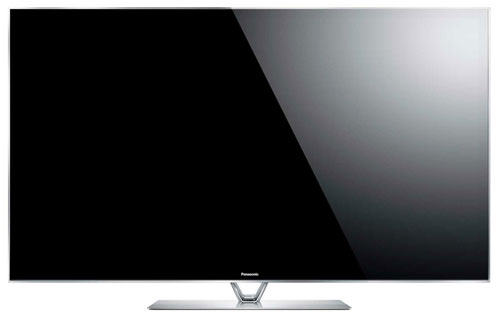
The Viera ZT65 (known in other, non-UK countries simply as the ZT60) is an unusual product for Panasonic to make. It might not be apparent in an era where the company is being undercut in price by its two major Korean rivals, but Matsushita Electric’s (now Panasonic’s) business strategy has evidently always centred around the admirable (and let’s face it, more profitable) route of opening high quality plasma display panel (PDP) technology up to the mass market. Producing goods that are “plentiful and inexpensive” (Matsushita’s words) sounds like the mission of many consumer electronics manufacturers, but it’s worth beginning this report with a reminder of how Panasonic has reduced the cost of entry to this display technology, and what they’ve done to make it affordable at average price points. Remember also that they have been doing this almost single-handedly, compared to their contemporaries which have either targeted a more exclusively high-end approach (Pioneer), or have decided to abandon PDP in favour of LED LCD TVs with higher margins (too many companies to mention).
Well, the TX-P60ZT65 is neither plentiful nor inexpensive. It’s a premium limited edition Plasma television priced at £4000. (That price, by the way, is many times higher than – in fact, nearly double – the equivalent model being sold in the American market). Although there have been Z-Series Panasonic Viera plasma TVs before, this is the first time the company has so obviously courted high-end, enthusiast AV users with an interest in video quality. The last Z-series product was 2009’s ultra-slim Z1 plasma, many of the most prominent selling points of which were functional and aesthetic features which could be described primarily as “lifestyle” additions (wireless HDMI transmission for cable-free tidiness and a super-slim design).
However, the ZT’s promotional material largely focuses on its premium picture quality. In European markets, the ZT65/ZT60 series comes in a single 60-inch size, with the model number for the UK being TX-P60ZT65B; and the rest of Europe, TX-P60ZT60. Not surprisingly, it’s loaded with the best of everything that Panasonic has to offer. It contains the Japanese manufacturer’s “Studio Master panel”, a marketing phrase referring to a new manufacturing process which bonds the panel directly to the front glass without any air gaps.
Don’t mistake this for an entirely new panel, however: the panel is the same as is found in the VT65 series, the difference being in the bonding. (Granted, we are arguing semantics here, since the word “panel” could either refer to the internal panel component, or the combination of the panel and the front glass and filter, that is, what is actually seen by the viewer). In any case, this new direct bonding process means that light from the screen can be directly transmitted to the outside world with absolutely no internal reflections. The result is the clarity (and we presume also much of the contrast efficiency?) of a “bare” panel, with zero internal reflections, with the aesthetics of a “one-sheet-of-glass” design, the best of both worlds.
The 3000hz Focused Field Drive (FFD) panel system is on board for clean motion, and the panel also features a drive algorithm that allows it to reproduce 30,720 shades of gradation for natural and dither-free details (especially in darker areas). All the image calibration controls the company has to offer are on board, as is a new red phosphor which allows the ZT65/ZT60 to reproduce most of the Digital Cinema Initiatives colour gamut. That’s an impressive engineering achievement, but not one that we can make use of at present, since all our existing HD content is designed for the standard HDTV Rec.709 colour gamut.
Perhaps most importantly of all, the Panasonic ZT promises to offer the deepest blacks seen yet on a plasma display. We’re expecting that its minimum luminance level (the darkest black the panel can reproduce under ideal dark-room conditions) will match, or perhaps even exceed the outstanding performance of the already spectacular VT65 series. Panasonic also promote the ZT65 as featuring exclusive “Ultimate Black” anti-reflective screen coating.
Can a Panasonic plasma aimed squarely at video enthusiasts surprise and delight us? Can it justify the steeper price point? Is it worth the extra cash over the cheaper mass-market models – especially given that the core panel component is the same as is found on the VT65 series? Will we stop asking questions and get on with the review?
The Viera TXP60ZT65B’s design is classy and understated. The “one-sheet-of-glass” styling is slick, as is the thin profile, but the most eye-catching feature to us is how totally black the screen manages to look even in the presence of ambient light.
One feature we personally feel is a step back compared to the VT65 series is the lack of transparent border. Designs are subjective, of course, and there’s really little to comment on either way given that the design is so subtly done.
The TXP60ZT65 also has a feature that’s been requested by videophile owners in dark rooms: its green power LED can be shut off. It’s very discreet anyway, but if you’re a user who’s annoyed by this, it’ll save you covering it up with masking tape (or a black Sharpie marker, for that matter…)

The ZT65’s remote design is a variation of the “high-end” remote that was bundled with the European VT30 series display. It feels more “premium” than the everyday Panasonic remote, but its backlighting is less efficient (for some reason only the number, volume and channel buttons are backlit).
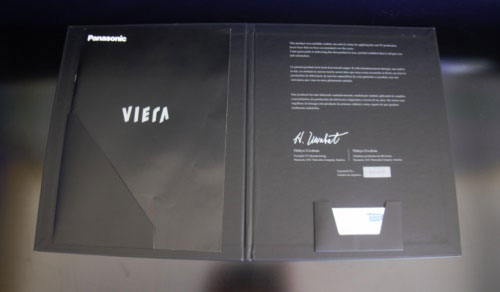 |
| (Image courtesy of Robert Zohn, Value Electronics, USA) |
Panasonic is also supplying the TX-P60ZT65B with a special owner’s box and commemorative booklet, which is signed by the lead engineer from Panasonic AVC Networks Company.
Strangely for such a top-end product, the 60ZT65 features only 3 HDMI inputs (we were expecting 4). With that said, on a flagship plasma that’s almost certainly going to be fed by a single AV receiver, it’s probably not too big an omission. Frivolously, the AV inputs are gold plated, which obviously don’t improve picture or sound quality (not unless you forgot to pick up your prescription for placebo-itis along with your crystal-infused premium HDMI cables, that is!)
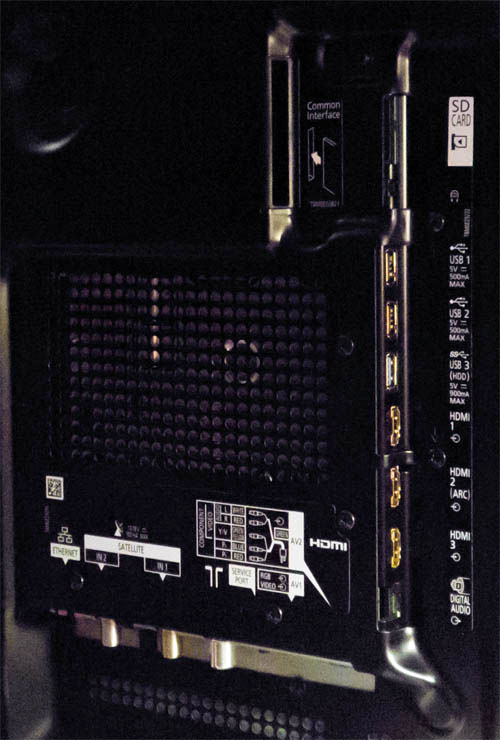 |
| Rear: 3 x HDMI, Component, SCART, antenna, Freesat, ethernet & audio outs |
User menus on the TX-P60ZT65 are basically the same as we’ve seen elsewhere on the 2013 Panasonic plasma range. There are plenty of accurate picture modes that can produce sufficiently high amounts of brightness, which was not always the case on last year’s models. There’s the “THX Cinema” mode, which is designed to give the best possible picture accuracy for users who won’t have their HDTVs individually calibrated – although given that the Panasonic ZT65 is sold via specialist dealers, we would hope that these same dealers will have a competent ISF or THX technician visit the home environment and carry out a full calibration as part of the deal (this is a £4000 signature plasma panel aimed at enthusiast users; we’d like to think the majority of units sold will end up being calibrated).
![[Picture] menu](https://www.hdtvtest.co.uk/news/wp-content/uploads/2018/04/hdtv_Panasonic-TXP60ZT65_picture1.jpg) |
| [Picture] menu |
The new “Custom” mode is here too. This mode gives full access to all the calibration controls, and has the added bonus of being accessible via the VIERA Remote 2 smart calibration iPad/Android app, for calibrators who want to adjust the picture quality performance without on-screen menus getting in the way. The calibrated settings can then be copied with a few button presses into the “Professional1” or “Professional2” (which can be renamed “ISF Day” and “ISF Night”). However, we’ve found that in practice, there are small internal differences to colour reproduction in the “Custom” mode compared to the “Pro” modes, so if you don’t want to use the calibration app, you might as well just calibrate directly into these modes.
There is one new interesting picture preset on the European ZT60s and British ZT65s, called “EBU Default”. It turns out that the European Broadcasting Union has had a recommendation on the performance characteristics of consumer displays since 2007, the tech document being EBU 3321 (link). (By the way, if you’re reading from outside this continent, then just think of the EBU as Europe’s equivalent to SMPTE). This mode is designed to comply with EBU tech doc 3321, although the EBU’s guidelines call for the same ITU-approved base picture characteristics as any other professional video institution. So, like both ISF and THX, this mode targets a Rec709 colour gamut and D65 white point. The only difference is the default gamma, which targets the EBU’s favoured 2.3, rather than the 2.2 or 2.4 we’re used to seeing. In reality, that difference is very small, however. Also, the EBU mode has a limited light output, similar to last year’s “Professional” modes, meaning that like a studio monitor, it favours supreme gamma accuracy at the cost of light output.
One other interesting feature is that it apparently adjusts the colour gamut based on the resolution of the incoming video. The other modes do have this option, but it’s a manual selection rather than an auto-detect. The difference is subtle, in any case.
We used the “Professional” modes thanks to their potential picture brightness and accuracy: they’re the best of both worlds. As with the TX-P55VT65B we reviewed, we used the “Mid” panel brightness setting and an increase of the [Contrast] control to get higher light output out of the TXP60ZT65B. We were able to hit our 120 cd/m2 light output target with the ZT, but only after a little bit of ageing (when the display was newer it was around 108 cd/m2, which is still entirely sufficient). This is great going for a plasma TV of this size.
For some reason, none of the picture modes on the Viera TXP60ZT65 preserve full dynamic range in the above-white portion of the video signal, by default. A service menu adjustment allows for full dynamic range (though we can’t imagine anyone will seriously mind) and high light output, but we haven’t tested the long term effects of this.
Note: Our Panasonic TX-P60ZT65B review sample was calibrated using Calman Professional, the industry-leading video calibration software.
After we selected our chosen “Professional” picture mode and allowed the ZT65 to age for a reasonable amount of time, we took some measurements of grey test screens to see how on-target the Panasonic ZT’s colouring of them was:
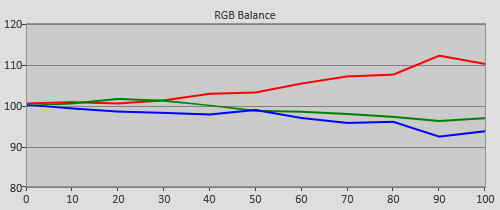 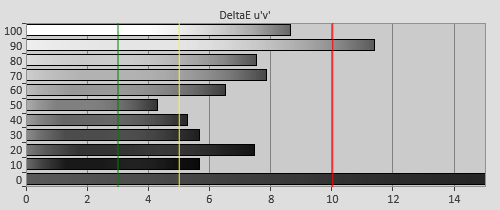 |
| Pre-calibration RGB tracking and delta errors (dEs) |
The performance here is near-identical to (but ironically enough, minutely worse than) the TX-P55VT65 review sample we reviewed. That’s not too surprising, given that they share the same panel (although not the process of bonding it to the front glass), and we made sure to age both for the same amount of time before taking these measurements. Like with the VT65, our TXP60ZT65 revealed an excess of red in highlight regions. That’s better than a green tint, although not preferable to a blue one – or no tint at all, for that matter!
It’s important for readers to note that this result was taken from the Panasonic TXP60ZT65B after the approximately 100 hours of breaking in that we gave it before publishing this review. A decent amount of shifting goes on when plasma televisions are new, and indeed, the image was more neutrally coloured in the first few hours (although the shift is so gradual that viewers won’t notice the change). This is why calibrators only recommend that they pay a visit after the screen has been used for a couple of hundred hours, when the biggest drifts have already been and gone.
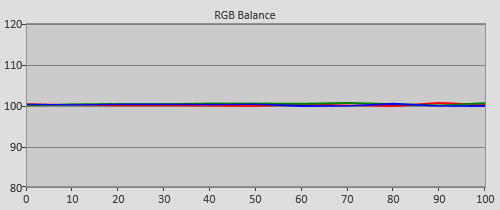 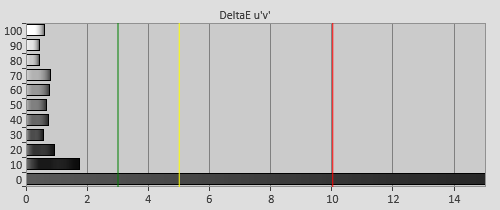 |
| Post-calibration RGB tracking and dEs in [Professional] mode |
Achieving supremely accurate greyscale tracking was no trouble at all on the Panasonic ZT65. We only had to make light use of the precise 10-point adjustments to reduce leftover tints, largely in shadowed areas. The result was very accurate greyscale colouring, which then acted as a solid base for colours to be laid on top of.
A remarkable trait of the Viera TX-P60ZT65 is its ability to hold onto consistently coloured grey shades even as the average brightness levels of the content being viewed change. For example, aligning a plasma TV with standard-sized windows and then re-checking with smaller windows or APL patterns tends to reveal some drift. That’s still the case with the ZT, but even when we re-measured with APL patterns, errors for the most part did not rise above the visible threshold of 3. (Gamma went a little higher, however).
![Pre-calibrated Gamma tracking in [Professional] mode](https://www.hdtvtest.co.uk/news/wp-content/uploads/2018/04/hdtv_Panasonic-TXP60ZT65_pre-gamma.png) | ![Post-calibrated Gamma tracking in [Professional] mode](https://www.hdtvtest.co.uk/news/wp-content/uploads/2018/04/hdtv_Panasonic-TXP60ZT65_post-gamma.png) |
| Pre-calibration gamma tracking (~2.1) | Post-calibration gamma tracking (2.4) |
The default tracking in the Professional mode averaged at a gamma of 2.1, which will produce a good-looking result in daytime viewing environments. For calibrating a “Night” mode for darker-room movie viewing, we target 2.4, which provides a supremely rich image in line with current Hollywood mastering practices.
Accurate gamma tracking makes all the difference especially for content which is predominantly dark, as is the case with the 1960s black and white Japanese movie Kuroneko which ended up being here during the review period. On one transfer of the film, blacks are actually mildly elevated above 0%, meaning that the film’s vast swathes of darkness are intended to be sitting just above black. Movies like this are a real test of a display’s gamma tracking, specifically how they “come out of black”: pre-calibrated, the just-above-blacks are actually reproduced as greys, decreasing the perception of contrast. Accurate gamma is the “icing on the cake” in terms of getting a rich, high-contrast image out of the panel.
Panasonic’s current HDTVs exhibit highly linear colour saturation tracking. Pre-calibration, all of the colours were tinged with a little too much red (notice how all of the points are gravitating towards the red area in the CIE chart), but they did so consistently:
![Pre-calibration Colour saturation tracking in [Professional] mode](https://www.hdtvtest.co.uk/news/wp-content/uploads/2018/04/hdtv_Panasonic-TXP60ZT65_pre-strack.jpg) |
| Pre-calibration colour saturation tracking |
![Pre-calibration colour errors in [Professional] mode](https://www.hdtvtest.co.uk/news/wp-content/uploads/2018/04/hdtv_Panasonic-TXP60ZT65_pre-strack-de.png) |
| Pre-calibration colour errors (<3 not appreciable to the eye) |
After calibration, the colour accuracy was perfect. Errors that register as having a delta error of less than 3 are essentially invisible to the eye anyway under normal viewing conditions, but our calibrated TXP60ZT65B had errors mostly less than ONE. (The errors, by the way, reflect the three aspects of colour performance: hue, saturation and luminance: every attribute is visibly perfect).
![Post-calibration Colour saturation tracking in [Professional] mode](https://www.hdtvtest.co.uk/news/wp-content/uploads/2018/04/hdtv_Panasonic-TXP60ZT65_post-strack.jpg) |
| Post-calibration colour saturation tracking |
![Post-calibration colour errors in [Professional] mode](https://www.hdtvtest.co.uk/news/wp-content/uploads/2018/04/hdtv_Panasonic-TXP60ZT65_post-strack-de.png) |
| Post-calibration colour errors (<3 not appreciable to the eye) |
When it came to the third dimension, the Panasonic TX-P60ZT65B produced essentially the same pre-calibrated greyscale accuracy as the step-down 55VT65. We measured this in the “THX3D Cinema” mode, which is the mode with the best combination of brightness (which is a critical issue for 3D, especially on large screen plasma TVs) and colour neutrality. Like the 2D output mode, the ZT65’s tri-dimensional images, when viewed through the glasses, were tinted red for the most part (although an excess of blue permeated shadows):
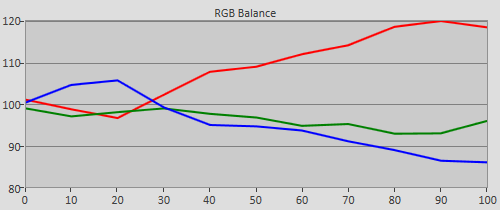 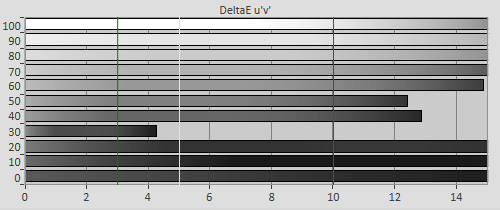 |
| 3D pre-calibration RGB tracking and delta errors (dEs) |
We cleaned up greyscale performance in 3-D by selecting the [Professional1] mode (which saves different settings independently in both 2D and 3D), and then adjusting the [Panel Luminance Setting] to “High” (which is what the THX3D Cinema mode also uses internally). This decreases gradation quality a little and increases noise, but unlike the 2D display mode, does not cause visible highlight clipping. It also, as the name suggests, offers higher brightness, which we feel is a big deal in 3D. From our point of view, the extra-dimensional image on a plasma-based 3DTV is a little noisy anyway, so a bit more in exchange for higher brightness is not going to hurt (much).
We then found what the most neutrally-coloured starting point was. Actually, since the excess of red was sizeable, selecting [Colour Temperature] of “Normal” (which tints the picture coming out of the TV blue-ish) resulted in a more accurate starting point when summed with the greeny-red tint of the glasses.
Then, we calibrated as normal using both 2-point and 10-point greyscale adjustment menus, to produce the following result:
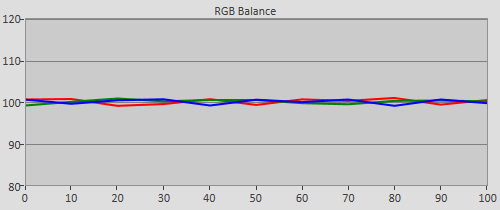 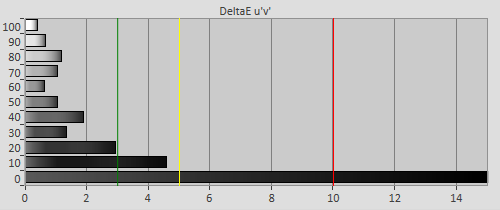 |
| 3D post-calibration RGB tracking and dEs in [Professional] mode |
![3D pre-calibration saturation tracking in [THX3D Cinema] mode](https://www.hdtvtest.co.uk/news/wp-content/uploads/2018/04/hdtv_Panasonic-TXP60ZT65_3d-pre-strack.jpg) |
| 3D pre-calibration saturation tracking |
![3D pre-calibration colour errors in [THX3D Cinema] mode](https://www.hdtvtest.co.uk/news/wp-content/uploads/2018/04/hdtv_Panasonic-TXP60ZT65_3d-pre-strack-de.png) |
| 3D pre-calibration colour errors (<3 not appreciable to the eye) |
![3D post-calibration saturation tracking in [Professional] mode](https://www.hdtvtest.co.uk/news/wp-content/uploads/2018/04/hdtv_Panasonic-TXP60ZT65_3d-post-strack.jpg) |
| 3D post-calibration saturation tracking |
![3D post-calibration colour errors in [Professional] mode](https://www.hdtvtest.co.uk/news/wp-content/uploads/2018/04/hdtv_Panasonic-TXP60ZT65_3d-post-strack-de.png) |
| 3D post-calibration colour errors (<3 not appreciable to the eye) |
| Dead pixels | None |
| Screen uniformity | Excellent |
| Overscanning on HDMI | Defeatable |
| Blacker than black | Passed |
| Calibrated black level (black screen) | 0.003 cd/m2 |
| Calibrated black level (ANSI checkerboard) | 0.004 cd/m2 |
| Black level retention | Stable |
| Primary chromaticity | Virtually flawless |
| Scaling | Excellent |
| Video mode deinterlacing | Very effective jaggies reduction |
| Film mode deinterlacing | Passed 2-2 PAL and 3-2 NTSC tests |
| Viewing angle | Excellent, but screen filter lessens vertical viewing angle |
| Motion resolution | 1080 lines |
| Digital noise reduction | Optional |
| Sharpness | Very Good, full resolution, almost invisible undefeatable high frequency sharpening |
| Luma/Chroma bandwidth (2D Blu-ray) | Full Luma, chroma has slight vertical limitation (even in [1080p Pure Direct] mode) |
| Image retention | Very little |
| Posterization | Mild, though worse with poor source |
| Phosphor trails | Very mild |
| 1080p/24 capability | No judder in 2D or 3D |
| Input lag (high-speed camera) | 23ms compared to lag-free CRT |
| Leo Bodnar lag tester | 41.5 ms |
| Full 4:4:4 reproduction (PC) | No, chroma vertically softened even in [1080p Pure Direct] mode |
| Default [Normal] mode (2D) | 169 watts |
| Default [Normal] mode (3D) | 270 watts |
| Calibrated [Professional] mode (2D) | 279 watts |
| Calibrated [Professional] mode (3D) | 460 watts |
| Standby | 1 watt |
| Jump To: 1. Design & CalibrationNext: Performance |
jQuery(document).ready(function($) { var toc = $("#tableofcontents").html(); $("#tablecontents").html(toc); });